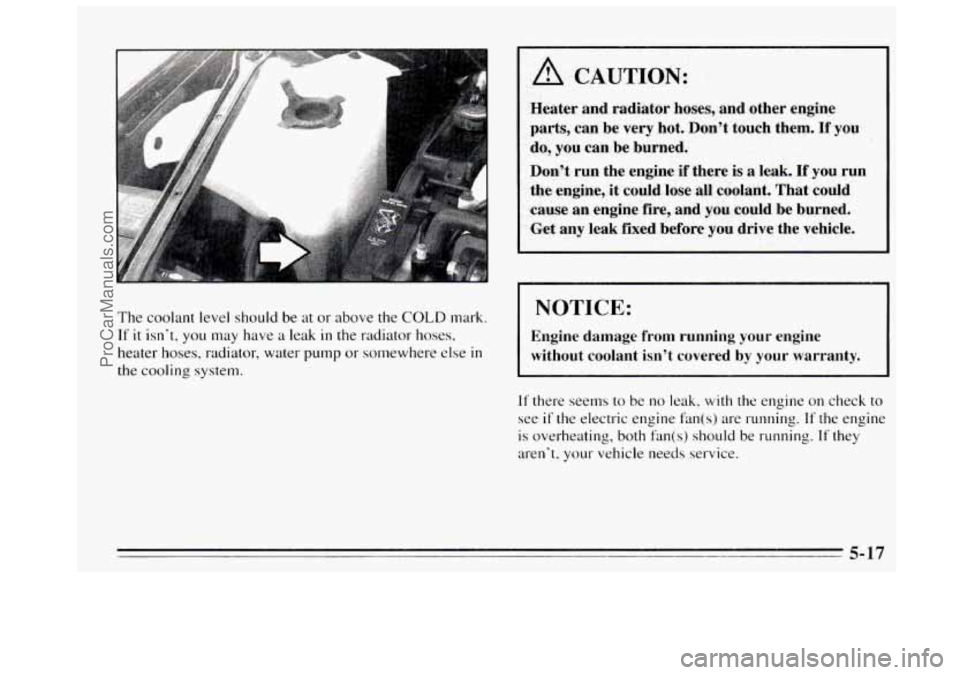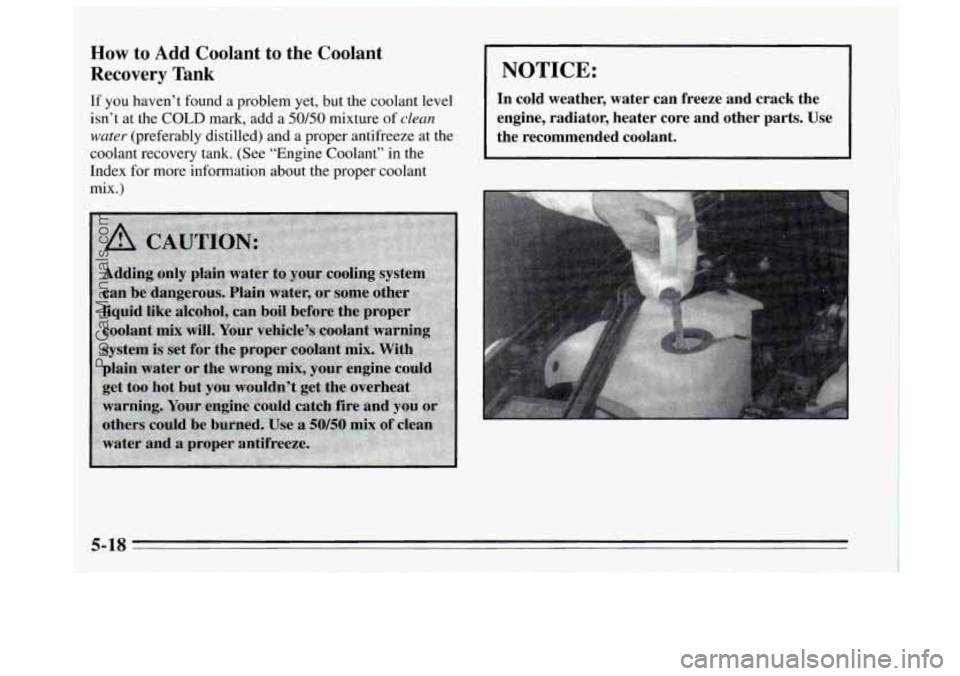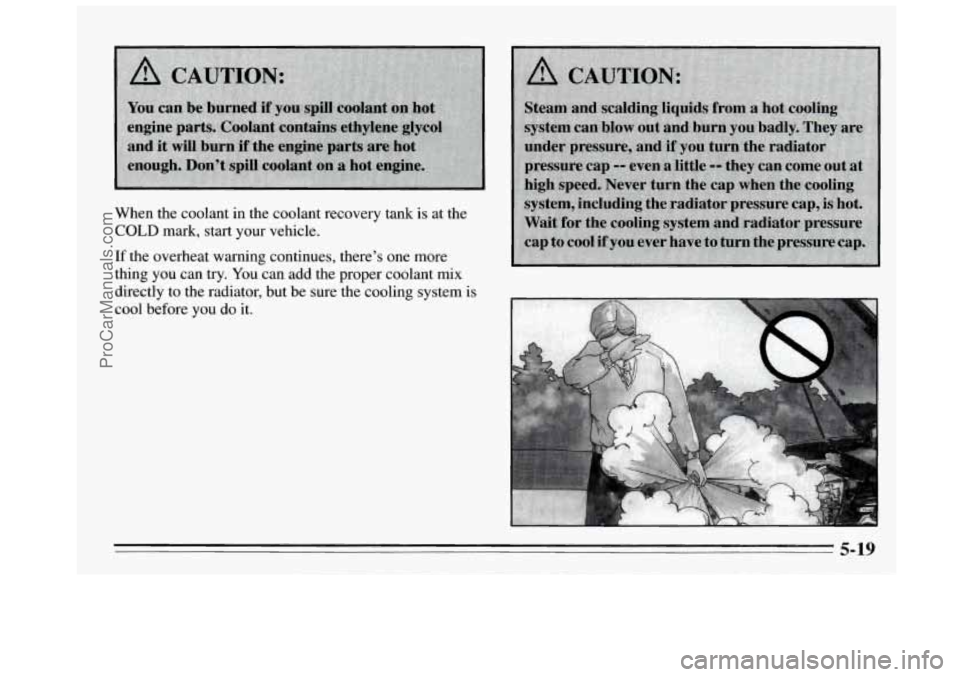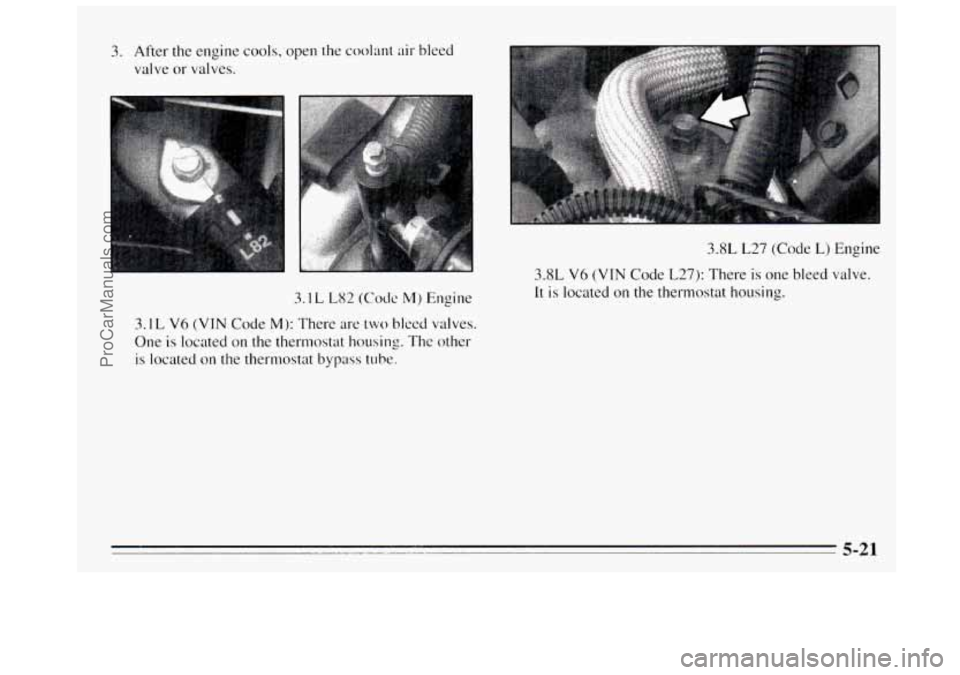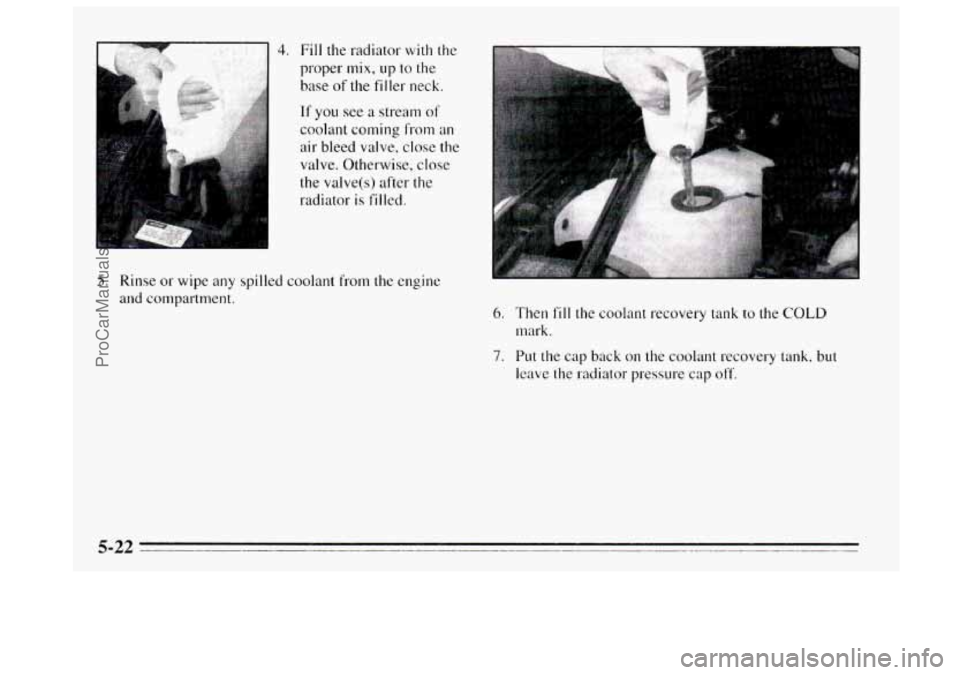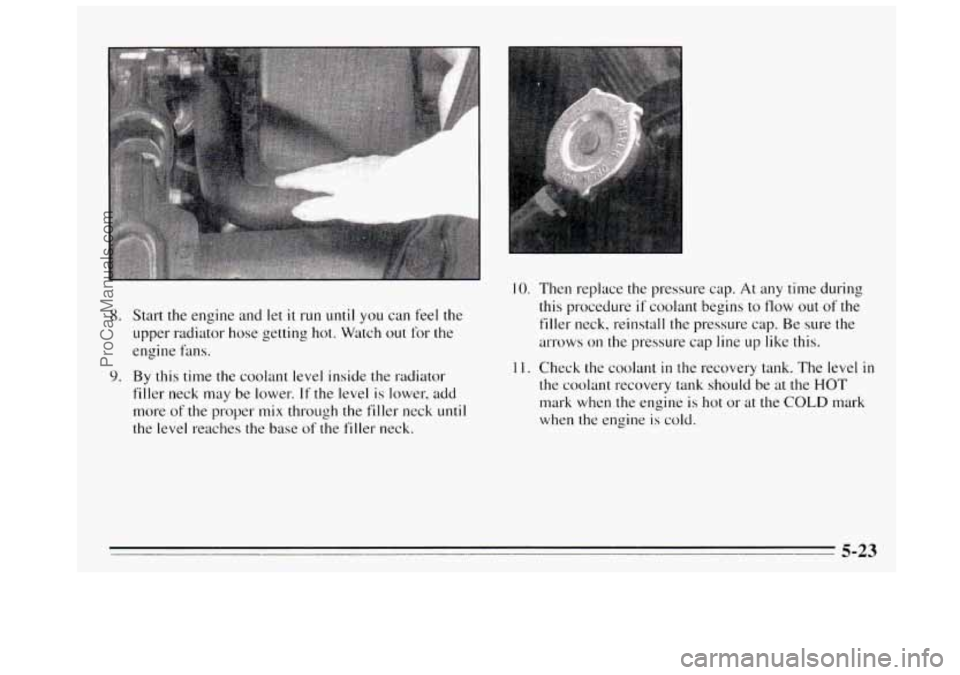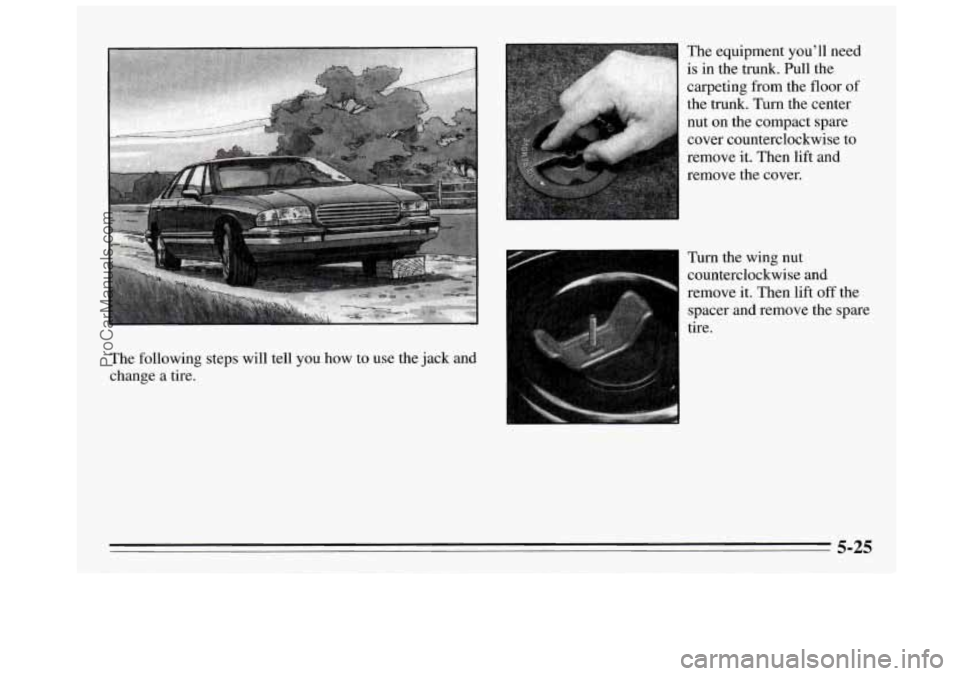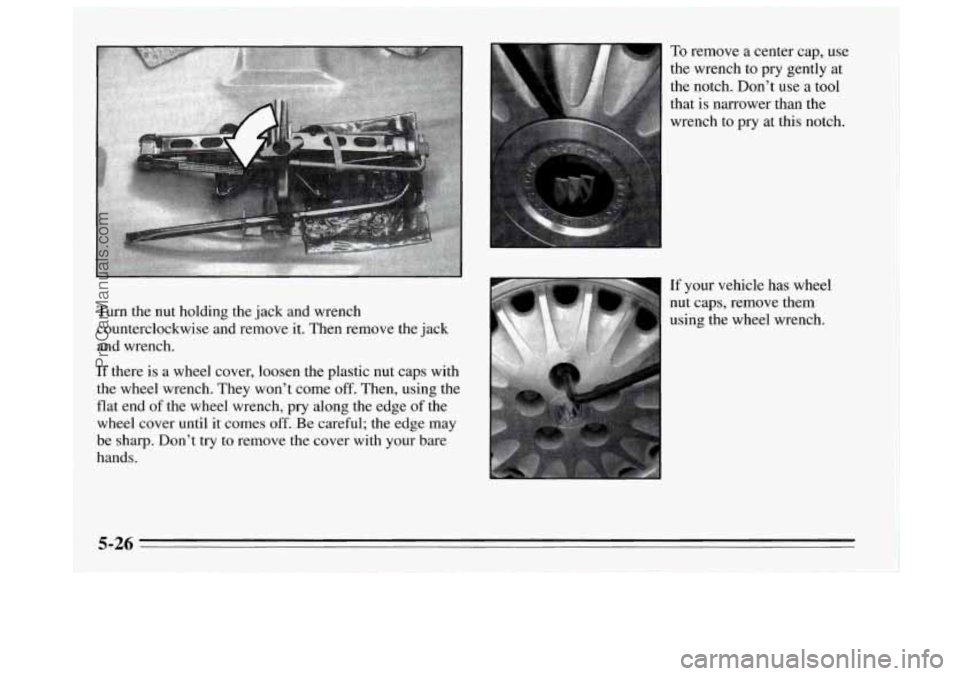BUICK REGAL 1995 Owners Manual
REGAL 1995
BUICK
BUICK
https://www.carmanualsonline.info/img/43/57696/w960_57696-0.png
BUICK REGAL 1995 Owners Manual
Trending: check engine, jump cable, buttons, coolant level, spare tire location, light, steering
Page 191 of 340
The coolant level should be at or above the COLD mark.
If it isn’t, you may have a leak in the radiator hoses,
heater hoses, radiator, water
pump or somewhere else in
the cooling system.
I A CAUTION:
Heater and radiator hoses, and other engine
parts, can be very hot. Don’t touch them.
If you
do,
you can be burned.
Don’t run the engine
i€ there is a leak. If you run
the engine, it could lose all coolant. That could
cause an engine fire, and you could be burned.
Get any leak fixed before you drive the vehicle.
NOTICE:
Engine damage from running your engine
without coolant isn’t covered
by your warranty.
If there seems to be no leak, with the engine on check to
see
if the electric engine fan(s) are running. If the engine
is overheating, both fan(s) should be running. If they
aren’t, your vehicle needs service.
ProCarManuals.com
Page 192 of 340
How to Add Coolant to the Coolant
Recovery Tank
If you haven’t found a problem yet, but the coolant level
isn’t at the
COLD mark, add a 50/50 mixture of clean
water (preferably distilled) and a proper antifreeze at the
coolant recovery tank. (See “Engine Coolant” in the
Index for more information about the proper coolant
mix.)
NOTICE:
In cold weather, water can freeze and crack the
engine, radiator, heater core and other parts. Use
the recommended coolant.
5-18
ProCarManuals.com
Page 193 of 340
When the coolant in the coolant recovery tank is at the
COLD mark, start your vehicle.
If the overheat warning continues, there’s one more
thing you can try. You can add the proper coolant
mix
directly to the radiator, but be sure the cooling system is
cool before you
do it.
5-19
ProCarManuals.com
Page 194 of 340
How to Add Coolant to the Radiator
NOTICE:
Your engine has a specific radiator fill procedure.
Failure to
follow this procedure could cause your
engine to overheat and be severely damaged.
1. You can remove the
radiator pressure cap
when the cooling
system, including the
radiator pressure
cap and
upper radiator hose,
is
no longer hot. Turn the
pressure
cap slowly to
the left until it first
stops. (Don’t press
down while turning
the pressure cap.)
IC you hear a hiss, wait for that to stop. A hiss means
there
is still some pressure left.
2. Then keep turning the
pressure cap, but now
push down
as you turn
it. Remove the pressure
cap.
5-20
ProCarManuals.com
Page 195 of 340
3. After the engine cools, open the coolant air bleed
valve or valves.
3.1 L L82 ((lode M) Engine
3.1L V6 (VTN Code M): There are two bleed valves.
One
is located on the thermostat housing. The other
is located on the thermostat bypass tube. 3.8L L27 (Code
L) Engine
3.8L V6 (VIN Code L27): There
is one bleed valve.
It is located on the thermostat housing.
ProCarManuals.com
Page 196 of 340
Fill the radiator with the
proper
mix, up to the
base of the filler neck.
If
you see a stream of
coolant coming horn an
air bleed valve, close the
valve. Otherwise, close
the valve(s) after the
radiator is filled.
5. Rinse or wipe any spilled coolant from the engine
and compartment.
6. Then fill the coolant recovery tank to the COLD
mark.
7. Put the cap back on the coolant recovery tank, but
leave the radiator pressure cap off.
ProCarManuals.com
Page 197 of 340
8. Start the engine and let it run until you can feel the
upper radiator hose getting hot. Watch
out for the
engine hns.
9. By this time the coolant level inside the radiator
filler neck may be lower.
If the level is lower, add
more
of the proper mix through the filler neck until
the level reaches the base of the filler neck.
10. Then replace the pressure cap. At any time during
this procedure
if coolant begins to flow out of the
filler neck, reinstall the pressure
cap. Be sure the
BI-~OWS on the pressure cap line up like this.
1 1 - Check the coolant in the recovery tank. The level in
the coolant recovery tank should be at the HOT
mark when the engine is hot or at the COLD mark
when the engine
is cold.
5-23
ProCarManuals.com
Page 198 of 340

If a Tire Goes Flat
It’s unusual for a tire to “blow out” while you’re driving,
especially if you maintain your tires properly. If air goes
out
of a tire, it’s much more likely to leak out slowly.
But
if you should ever have a “blowout,” here are a few
tips about what
to expect and what to do:
If a front tire fails, the flat tire will create a drag that
pulls the vehicle toward that side. Take your foot off the
accelerator pedal and grip
the steering wheel firmly.
Steer to maintain lane position, then gently brake
to a
stop well
out of the traffic lane.
A rear blowout, particularly on a curve, acts much like a
skid and may require the same correction you’d use
in a
skid. In any rear blowout, remove your foot from the
accelerator pedal. Get
the vehicle under control by
steering the way
you want the vehicle to go. It may be
very bumpy and noisy, but
you can still steer. Gently
brake
to a stop, well off the road if possible.
If a tire goes flat, the next part shows how to use your
jacking equipment to change
a flat tire safely.
5-24
ProCarManuals.com
Page 199 of 340
The following steps will tell you how to use the jack and
change a tire. The
equipment you’ll need
is in the trunk. Pull the
carpeting from the floor
of
the trunk. Turn the center
nut on the compact spare
cover counterclockwise to
remove it. Then lift and
remove the cover.
Turn the wing nut
counterclockwise and
remove it. Then lift
off the
spacer and remove the spare
tire.
5-25
ProCarManuals.com
Page 200 of 340
Turn the nut holding the jack and wrench
counterclockwise and remove it. Then remove the jack
and wrench.
If there is a wheel cover, loosen the plastic nut caps with
the wheel wrench. They won’t come off. Then, using the
flat end
of the wheel wrench, pry along the edge of the
wheel cover until it comes
off. Be careful; the edge may
be sharp. Don’t
try to remove the cover with your bare
hands.
To remove a center cap, use
the wrench to pry gently at
the notch. Don’t use a tool
that is narrower than the
wrench to pry at this notch.
If your vehicle has wheel
nut caps, remove them
using the wheel wrench.
5-26
ProCarManuals.com
Trending: trip computer, spare wheel, water pump, coolant level, inflation pressure, service interval, maintenance
